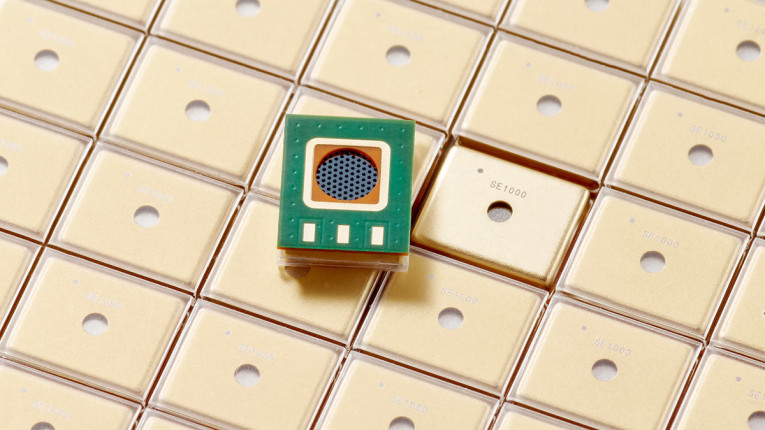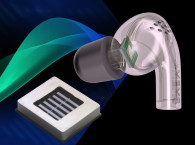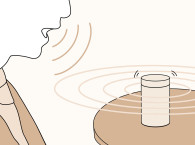
Let’s start with the general speaker population. We characterize speakers by how they move air, more particularly their various types of motors and diaphragms.
The moving force can be electro-dynamic - the usual voice coil in a magnetic structure driving a cone or dome - or a planar film diaphragm with laminated conductor pattern in a magnetic field. Oskar Heil’s air motion transformer (AMT) features an accordion-pleated diaphragm using the squeezing of the pleats to move air, but otherwise similar to tensioned diaphragm magnetic planars. One recent reincarnation of the AMT, (sort of, on a microscale) could be the Arioso MEMS speaker, which uses electrostatic actuators integrated inside 20µm wide bending strips, which are energized by vibrations from the audio signal voltage. Arioso Systems was recently acquired by Bosch.
Another more esoteric approach are electrostatic planars, which use a metalized diaphragm between grids. Microelectromechanical systems (MEMS) speakers are a new crop, mostly in that their acoustic production can be capacitive or piezo-electric as the driving force for the diaphragm. Admittedly I have given all these the short shift and each has enough variants to fill a book.
Now we move on to another universe of transducers that do not quite follow the usual rules of acoustic production. These are the modulated and parametric speakers that have been proposed and are now moving through development.
Perhaps you might remember back to 2009 to Woody Norris and his Hypersonic Sound Speaker (HSS). These were a class of ultrasound transducers that generated audible sound from modulated ultrasound. The modulated ultrasound passes through a nonlinear medium that acts as a demodulator. Projecting a narrow beam of modulated ultrasound substantially changes the speed of sound in the air that it passes through. The air within the beam behaves nonlinearly and extracts the modulation signal from the ultrasound, resulting in sound that can be heard only along the path of the beam, or that appears to radiate from any surface that the beam strikes.
Basically, the heterodyne speaker uses ultrasonic modulators of two beams with the difference creating the audio. This technology allows a beam of sound to be heard only in a small well-defined area; for a listener outside the beam the sound pressure decreases substantially.
And Now... A Unique Ultrasonic Shutter MEMS-Based Speaker System
Percolating in stealth mode for a decade is the work of Moti Margalit, CEO, and Ari Mizrachi (COO) of SonicEdge, today leading a growing team, including some in their Danish subsidiary. The core of the design is one or more apertures driven by the ultrasonic carrier signal and one or more movable and over-sized obstruction elements that are configured to modulate the ultrasonic carrier signal (think of a shutter) thereby generating audio.
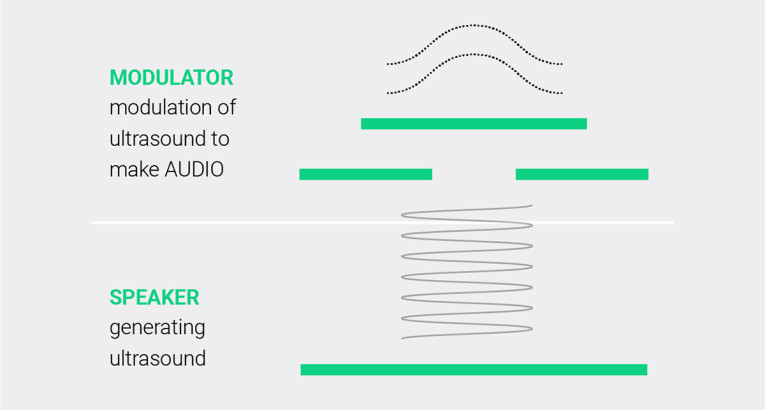
The ultrasound propagates through a time varying acoustic channel, which is an acoustic modulator. A large channel enables the ultrasound to pass, and a small channel attenuates the ultrasound. The modulator shifts shifting the ultrasound frequency creates a constant volume velocity source. A standard speaker in earphone applications has a constant sound level for lower frequencies and drops short at higher frequencies (black line). A volume velocity source provides a constant volume velocity of air regardless of frequency and in earphone applications has increasing SPL for lower frequencies and extended SPL at high frequencies (green line).
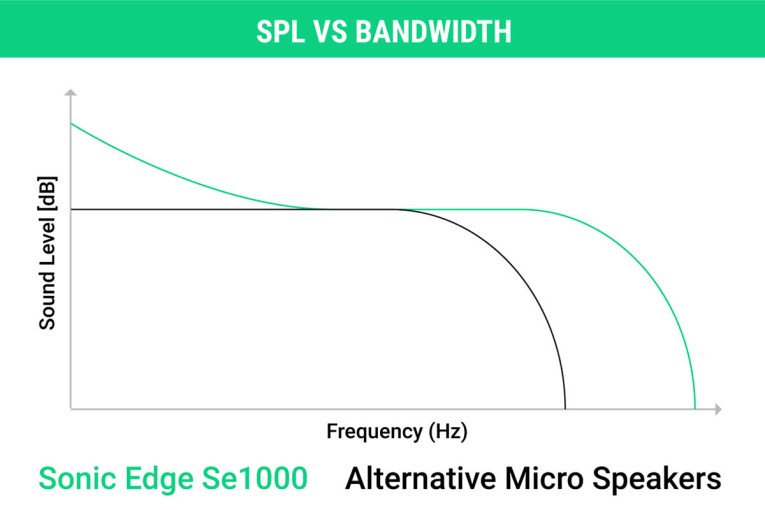
As can be seen from the graphs, this technique overcomes the challenge of large excursion and piston size in MEMS speakers by using a radically new approach based on active modulation of ultrasound. The SonicEdge speaker is composed of membranes generating modulated ultrasound and acousto-mechanical demodulators that frequency shift the ultrasound to audio.
The MEMS speaker is based on existing process modules for ultrasound transducers, such as Capacitive Micromachined Ultrasound Transducers (CMUT) or Piezoelectric Micromachined Ultrasonic Transducers (PMUTs).
The resulting game-changing speaker is a constant volume velocity source, generating-resonance free audio and ideally suited for non-occluded earphones and headsets with ANC functionality.

Back in 2018 I first came across this technology in my consulting work and some of the many patents that belong to SonicEdge. Since then, work has continued and SonicEdge was formed to complete development of the concept. Around this time last year SonicEdge emerged from “stealth mode” and first appeared in the MEMS microspeaker directory published in Voice Coil May 2022. Currently, SonicEdge is conducting POC projects with an evaluation board for strategic customers, with commercial availability of its first MEMS speaker (SE1000), anticipated for later in 2023 (specifications below).
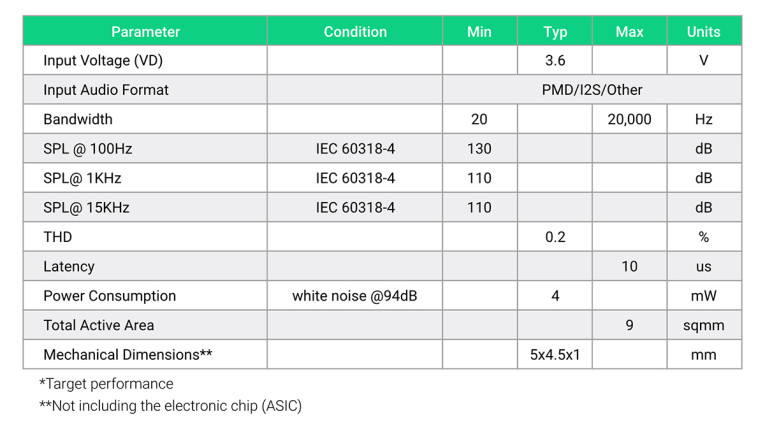
This ultrasound nano-speaker and frequency transformers are realized as a solid-state MEMS device manufactured monolithically leveraging the semiconductor eco system for scalability and price trajectory. Coming from the semiconductor fab as a final device in minimal size, which includes a MEMS chip that generates sound and an ASIC amplifier chip that drives the MEMS chip, SonicEdge has developed a unique technology that generates ultrasound from multiple acoustic pixels, each as wide as a strand of hair. The back cavity is 10x reduced in size compared to state-of-the-art 11mm drivers and therefore supports new design paradigms for earphones. The lack of a magnetic structure also relieves the TWS pain-point of providing enough separation between the antenna and the transducer.
There are advantages in size and sound quality, no mechanical vibrations, potentially low power consumption, and more SPL than what some of the earlier MEMS speaker efforts. The minuscule vibration produced with this sound product technique enables a lot more acoustic echo cancelation (AEC) and feedback margin in applications such as TWS and hearing aids, along with full-duplex speaker-as-mic functionality, together with some other sensing capabilities.
Having taken a good listen at CES this year, the device sounded excellent, as did some of the other recent MEMS earphones. SonicEdge’s product roadmap also includes bass reflex acoustic design supporting full-range free-field speakers for AR/VR and mobile device applications.
More information: www.sonicedge.io
